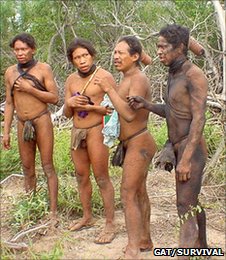The Dry Chaco is a dry section that also covers parts of Argentina, Bolivia and Brazil and some of the Ayoreo people have never had contact with the outside world.
Iniciativa Amotocodie (IA), the group calling out the Museum for its incursion, fears the actions will disturb the people. The Musuem's response; "We always take advice on these issues from the relevant national authorities, as we are doing in Paraguay."

Natives only get a voice if academics want to block local progress, not if it is something academics got a grant to do.
In other words, it's technically legal and they want to do it, so concerns about indigenous people from actual concerned groups are secondary. It sounds like the sort of thing BP or a military group would say but that is often the issue when the desires of research conflict with the desires of culture. A while back I wrote about the LOHAFEX expedition (LOHAFEX - If You Mean Well, Are You Allowed To Screw Up The Ocean?), which thought it was a good idea to dump a lot of iron into the ocean and see if the resulting algal blooms absorbed more carbon, clearly in violation of the United Nation's Convention on Biological Diversity that put a moratorium on widespread experimentation with the ocean - 191 nations including Germany, who were the lead proponents of the restriction and then sponsored the trip violating it.
But they found a loophole and it was therefore "legal" so they did it anyway, over the objections of basically the entire planet. And so the NHM rationalizes their trip will help natives there, even if it hurts them, which is basically a way of putting on blinders when you want to do something and have legal authority but don't want ethics to get in the way.
There are only 5,000 Ayoreo people in total and only a few hundred have never been 'contacted' in any way so the core issues are two-fold: First, is it important or not, in a modern world, to keep these people from being contacted now when it could happen a year from now and; second, this area is huge, why is it essential for this Museum expedition to go to the ancestral home of the Ayoreo tribe in order to 'record' this biodiversity and risk giving this native people, who will have no immunity to many diseases they could easily catch?
Both are ethical issues but NHM has clearly come down in favor of their own desires over the residents, no different than the logging companies and agriculture companies they claim to be concerned about. Like logging companies, the NHM takes "advice on these issues from the relevant national authorities, as we are doing in Paraguay."
The NHM wants to work with "governments and conservation groups better understand how to manage fragile habitats and protect them for future generations," says Professor Richard Lane, Director of Science at the Museum.
Yes, they intend to risk the indigenous peoples' lives so that they can draw attention to the need to protect the habitat, which they say will be under threat from the expansion of logging and intensive agriculture - in other words, everyone else is the threat except the NHM. I assume you see the irony in that.




Comments